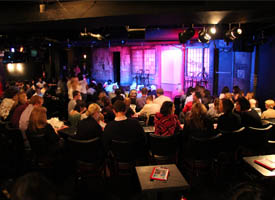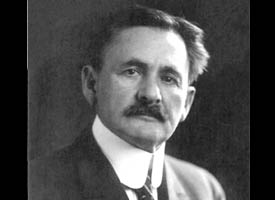- Details
 The Second City comedy troupe debuted 56 years ago today at a former laundromat on Chicago’s North Side. Since their first performance, Second City has become known worldwide and produced popular comedic artists including Dan Aykroyd to John Belushi and Bill Murray.
The Second City comedy troupe debuted 56 years ago today at a former laundromat on Chicago’s North Side. Since their first performance, Second City has become known worldwide and produced popular comedic artists including Dan Aykroyd to John Belushi and Bill Murray.
In 1976, Second City started a late-night television show with John Candy, Harold Ramis and George Wendt. A host of Second City comedians have performed on “Saturday Night Live,” beginning almost immediately after the show debuted in the mid-1970s.
Today, Second City performs at comedy clubs in Chicago, Southern California and Toronto, Canada.
Learn more:
Read more about the history of The Second City
- Details
 Former pro football player and current analyst for NBC’s “Football Night in America” Rodney Harrison was born December 15, 1972 in Markham. Harrison attended Marian Catholic High School in Chicago Heights, where he starred under legendary coach Dave Mattio. After starting for three years as safety for Marian, Harrison earned a scholarship to play at Western Illinois University, where he became an All-American.
Former pro football player and current analyst for NBC’s “Football Night in America” Rodney Harrison was born December 15, 1972 in Markham. Harrison attended Marian Catholic High School in Chicago Heights, where he starred under legendary coach Dave Mattio. After starting for three years as safety for Marian, Harrison earned a scholarship to play at Western Illinois University, where he became an All-American.
Harrison was drafted in the 5th round of the 1994 NFL Draft by the San Diego Chargers and went on to become the starting safety as rookie. The 1994-95 Chargers went on to play in Super Bowl XXIX against the San Francisco 49ers. Following the 2002 season, Harrison signed with the New England Patriots and subsequently won two Super Bowls with the team and playing in a fourth in 2008.
Harrison retired in 2009 and joined NBC Sports’ “Football Night in America.” Harrison ended his career as a two-time Super Bowl champion, two-time Pro Bowler and as one of only 12 players in the history of the NFL to record at least 20 interceptions and 20 sacks in his career.
Learn more:
Rodney Harrison’s biography
Read more about Harrison’s stats during his NFL career here
- Details
 The Shedd Aquarium first opened its doors on May 30, 1930, after years of planning and a generous $2 million donation by John G. Shedd, a Chicago businessman who led Marshall Field & Co. to become the largest wholesale and dry goods company in the world.
The Shedd Aquarium first opened its doors on May 30, 1930, after years of planning and a generous $2 million donation by John G. Shedd, a Chicago businessman who led Marshall Field & Co. to become the largest wholesale and dry goods company in the world.
Since opening 85 years ago, the aquarium has undergone several expansions and upgrades. Abbott Oceanarium opened in 1991 and is home to beluga whales, sea lions and Pacific white-sided dolphins. Shedd’s newest attraction, Wild Reef, features sharks, stingrays and vast coral exhibits.
Roughly two million patrons visit the Shedd Aquarium each year.
Learn more:
Read more about the history and historic architecture of Shedd Aquarium
To vote for the name of Shedd’s newest Pacific white-sided dolphin, click here
- Details
 Chancelor Johnathan Bennett, known as Chance the Rapper, was born in Chicago on April 16, 1993. Chance grew up on Chicago’s South Side and attended Jones College Prep High School. He recorded his first mixtape while still in high school, releasing his second mixtape two years later in 2013. He released his first studio album, a collaborative album titled Surf, on May 28 of this year.
Chancelor Johnathan Bennett, known as Chance the Rapper, was born in Chicago on April 16, 1993. Chance grew up on Chicago’s South Side and attended Jones College Prep High School. He recorded his first mixtape while still in high school, releasing his second mixtape two years later in 2013. He released his first studio album, a collaborative album titled Surf, on May 28 of this year.
Learn more:
Read more about Chance the Rapper’s appearance on this week’s Saturday Night Live
- Details
 Albert Abraham Michelson was born in December of 1852 in Prussia, immigrating to the United States with his family two years later. After serving briefly in the U.S. Navy, Michelson taught physics at the Case School of Applied Science in Cleveland and later at Clark University in Worcester, Massachusetts. In 1892, he was appointed head of the physics department at the University of Chicago.
Albert Abraham Michelson was born in December of 1852 in Prussia, immigrating to the United States with his family two years later. After serving briefly in the U.S. Navy, Michelson taught physics at the Case School of Applied Science in Cleveland and later at Clark University in Worcester, Massachusetts. In 1892, he was appointed head of the physics department at the University of Chicago.
It was during his time in Chicago that Michelson became well-known in the field of physics. His work to measure the speed of light gained him notoriety and helped him receive the Nobel Prize in 1907. While Michelson was not successful in determining the speed of light, his experiments eventually paid off and the speed of light was discovered just two years after his death.
Learn more:
Read more about the life and accomplishments of Albert A. Michelson
More Articles …
- Did You Know? The Lyman Trumbull House is located in Illinois
- Did You Know? Civil rights leader Fred Hampton was from Illinois
- Did You Know? Illinois is home to the largest convention center in North America
- Did You Know? Singer/songwriter Lou Rawls was from Illinois
- Did You Know? Labor-rights activist “Mother” Jones had ties to Illinois





